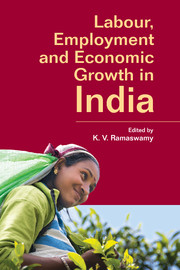Book contents
- Frontmatter
- Dedication
- Contents
- List of Tables and Figures
- Preface
- Part 1 Economic Growth and Employment
- Part 2 Employment and Labour Law
- 8 From Rigidity to Flexibility
- 9 Employment Protection Legislation and Threshold Effects
- 10 Who is a Worker?
- 11 Labour Jurisprudence of the Supreme Court
- Contributors
- Index
10 - Who is a Worker?
from Part 2 - Employment and Labour Law
Published online by Cambridge University Press: 05 June 2015
- Frontmatter
- Dedication
- Contents
- List of Tables and Figures
- Preface
- Part 1 Economic Growth and Employment
- Part 2 Employment and Labour Law
- 8 From Rigidity to Flexibility
- 9 Employment Protection Legislation and Threshold Effects
- 10 Who is a Worker?
- 11 Labour Jurisprudence of the Supreme Court
- Contributors
- Index
Summary
Introduction
There appears to be a persistent paradox that dogs the Indian economy – namely, that in spite of a comparatively high rate of growth of output, the expansion in formal employment is quite small. It is standard practice to attribute this to the constriction in the demand for labour caused by restrictive labour laws. The laws are perceived to inhibit employers from hiring maximal number of workers because employers have to carry ‘stocks’ of labour even when there are product market downturns, leading employers to constrain hiring and possibly increase capital–labour ratios. However, while this question is central to the contemporary policy imagination, it needs to be realized that the role of labour law and regulation in labour markets is more complex than merely reducing it to a question of the law governing the hiring and firing of workers in response to fluctuations in product demand. A more nuanced understanding of the role of labour market institutions raising questions about the scope and coverage of labour law as the Indian economy sets about transforming itself, is an essential input for the contemporary policymaker.
A recent review article by MacLeod makes one aware of the pitfalls of standard labour market analysis. He reminds one that the traditional study of labour markets is content to work with a competitive model where wages reflect the abilities of workers as well as the efficient allocation of labour, though these outcomes may be inequitable in many ways. Apart from signifying inequitable distribution of income, they represent inadequate insurance for workers in the face of unforeseen labour shocks. The many institutions that surround labour concerns like minimum wages, unions, termination compensation, unemployment insurance, centralized bargaining, are typically viewed as devices that compensate these risks and inequities. If it is believed on faith that the market generates economic efficiency, then these interventions cannot but generate inefficiency. This in turn means that there is an inevitable equity (fairness) – efficiency trade off.
- Type
- Chapter
- Information
- Labour, Employment and Economic Growth in India , pp. 265 - 291Publisher: Cambridge University PressPrint publication year: 2015
- 2
- Cited by



